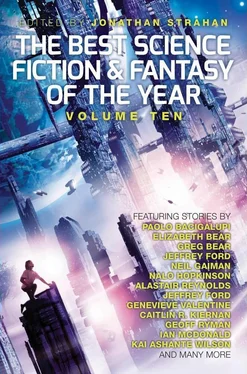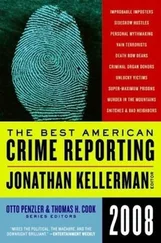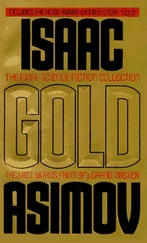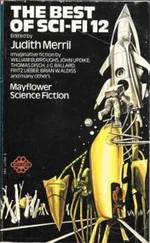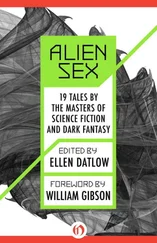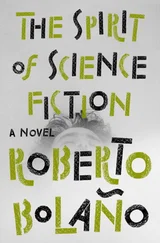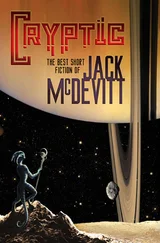Kraken was a better scientist, or at least a better-understood one. Kraken was a better person, probably. More generous, less prickly, certainly. But there was one thing Dharthi was good at. Better at than Kraken. Better at than anyone. Dharthi was good at living on Venus, at being Cytherean. She was more comfortable in and proficient with an adaptshell than anyone she had ever met.
In fact, it was peeling the shell off that came hard. So much easier to glide through the jungle or the swamp like something that belonged there, wearing a quasibiologic suit of super-powered armor bonded to your neural network and your skin. The human inside was a soft, fragile, fleshy thing, subject to complicated feelings and social dynamics, and Dharthi despised her. But that same human, while bonded to the shell, ghosted through the rain forest like a native, and saw things no one else ever had.
A kilometer from where she had stopped for cake, she picked up the trail of a velociraptor. It was going in the right direction, so she tracked it. It wasn’t a real velociraptor; it wasn’t even a dinosaur. Those were Terran creatures, albeit extinct; this was a Cytherean meat-eating monster that bore a superficial resemblance. Like the majority of Cytherean vertebrates, it had six limbs, though it ran balanced on the rear ones and the two forward pairs had evolved into little more than graspers. Four eyes were spaced equidistantly around the dome of its skull, giving it a dome of monocular vision punctuated by narrow slices of depth perception. The business end of the thing was delineated by a sawtoothed maw that split wide enough to bite a human being in half. The whole of it was camouflaged with long draggled fur-feathers that grew thick with near-black algae, or the Cytherean cognate.
Dharthi followed the velociraptor for over two kilometers, and the beast never even noticed she was there. She smiled inside her adaptshell. Kraken was right: going out into the jungle alone and unsupported would be suicide for most people. But wasn’t it like her not to give Dharthi credit for this one single thing that Dharthi could do better than anyone?
She knew that the main Cytherean settlements had been on Ishtar Terra. Knew it in her bones. And she was going to prove it, whether anybody was willing to give her an allocation for the study or not.
They’ll be sorry , she thought, and had to smile at her own adolescent petulance. They’re rush to support me once this is done.
The not-a-dinosaur finally veered off to the left. Dharthi kept jogging/ swinging/swimming/splashing/climbing forward, letting the shell do most of the work. The highlands leveled out into the great plateau the new settlers called the Lakshmi Planum. No one knew what the aboriginals had called it. They’d been gone for – to an approximation – ten thousand years: as long as it had taken humankind to get from the Neolithic (Agriculture, stone tools) to jogging through the jungles of alien world wearing a suit of power armor engineered from printed muscle fiber and cheetah DNA.
Lakshmi Planum, ringed with mountains on four sides, was one of the few places on the surface of Venus where you could not see an ocean. The major Cytherean land masses, Aphrodite and Ishtar, were smaller than South America. The surface of this world was 85% water – water less salty than Earth’s oceans, because there was less surface to leach minerals into it through runoff. And the Lakshmi Planum was tectonically active, with great volcanoes and living faults.
That activity was one of the reasons Dharthi’s research had brought her here.
The jungle of the central Ishtarean plateau was not as creeper-clogged and vine-throttled as Dharthi might have expected. It was a mature climax forest, and the majority of the biomass hung suspended over Dharthi’s head, great limbs stretching up umbrella-like to the limited light. Up there, the branches and trunks were festooned with symbiotes, parasites, and commensal organisms. Down here among the trunks, it was dark and still except for the squish of loam underfoot and the ceaseless patter of what rain came through the leaves.
Dharthi stayed alert, but didn’t spot any more large predators on that leg of the journey. There were flickers and scuttlers and flyers galore, species she was sure nobody had named or described. Perhaps on the way back she’d have time to do more, but for now she contented herself with extensive video archives. It wouldn’t hurt to cultivate some good karma with Bio while she was out here. She might need a job sweeping up offices when she got back.
Stop. Failure is not an option. Not even a possibility.
Like all such glib sentiments, it didn’t make much of a dent in the bleakness of her mood. Even walking, observing, surveying, she had entirely too much time to think.
She waded through two more swamps and scaled a basalt ridge – one of the stretching roots of the vast volcano named Sacajawea. Nearly everything on Venus was named after female persons – historical, literary, or mythological – from Terra, from the quaint old system of binary and exclusive genders. For a moment, Dharthi considered such medieval horrors as dentistry without anesthetic, binary gender, and as being stuck forever in the body you were born in, locked in and struggling against what your genes dictated. The trap of biology appalled her; she found it impossible to comprehend how people in the olden days had gotten anything done, with their painfully short lives and their limited access to resources, education, and technology.
The adaptshell stumbled over a tree root, forcing her attention back to the landscape. Of course, modern technology wasn’t exactly perfect either. The suit needed carbohydrate to keep moving, and protein to repair muscle tissue. Fortunately, it wasn’t picky about its food source – and Dharthi herself needed rest. The day was long, and only half over. She wouldn’t prove herself if she got so tired she got herself eaten by a megaspider.
We haven’t conquered all those human frailties yet.
Sleepily, she climbed a big tree, one that broke the canopy, and slung a hammock high in branches that dripped with fleshy, gorgeous, thickly scented parasitic blossoms, opportunistically decking every limb up here where the light was stronger. They shone bright whites and yellows, mostly, set off against the dark, glossy foliage. Dharthi set proximity sensors, established a tech perimeter above and below, and unsealed the shell before sending it down to forage for the sorts of simple biomass that sustained it. It would be happy with the mulch of the forest floor, and she could call it back when she needed it. Dharthi rolled herself into the hammock as if it were a scentproof, claw-proof cocoon and tried to sleep.
Rest eluded. The leaves and the cocoon filtered the sunlight, so it was pleasantly dim, and the cocoon kept the water off except what she’d brought inside with herself when she wrapped up. She was warm and well-supported. But that all did very little to alleviate her anxiety.
She didn’t know exactly where she was going. She was flying blind – hah, she wished she were flying. If she’d had the allocations for an aerial survey, this would all be a lot easier, assuming they could pick anything out through the jungle – and operating on a hunch. An educated hunch.
But one that Kraken and her other colleagues – and more importantly, the Board of Allocation – thought was at best a wild guess and at worst crackpottery.
What if you’re wrong?
If she was wrong... well. She didn’t have much to go home to. So she’d better be right that the settlements they’d found on Aphrodite were merely outposts, and that the aboriginal Cythereans had stuck much closer to the North pole. She had realized that the remains – such as they were – of Cytherean settlements clustered in geologically active areas. She theorized that they used geothermal energy, or perhaps had some other unknown purpose for staying there. In any case, Ishtar was far younger, far more geologically active than Aphrodite, as attested by its upthrust granite ranges and its scattering of massive volcanoes. Aphrodite – larger, calmer, safer – had drawn the Terran settlers. Dharthi theorized that Ishtar had been the foundation of Cytherean culture for exactly the opposite reasons.
Читать дальше
